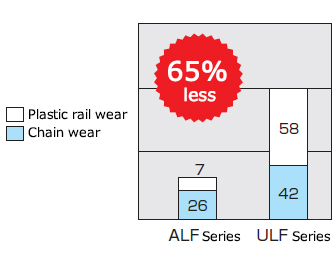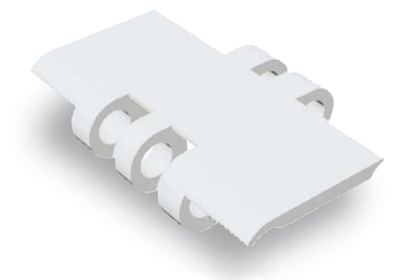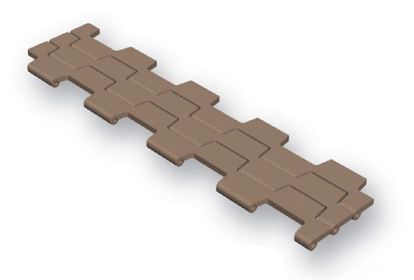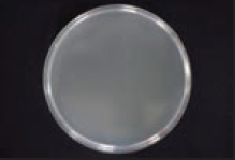Technical Data Top chain Selection
These are common pages for plastic modular chains (mold-to-width type), top chains, and plastic block chains.
To view selection procedures and precautions, please proceed to the following.
Click here to narrow down the product series or to make a tentative selection.
If you have specific conditions of use and wish to make a detailed selection, please click here.
Selection Process for Top Chain
Follow the process below to select the top chain and the wearstrip that are most suitable for the application.
(Click on each item to scroll to the main text. )
- 1. Check Conveyance Conditions
- 2. Select Top Plate Material and Chain Type
- 3. Select Wearstrip Material
- 4. Determine Coefficient
- 5. Calculate Chain Tension and Power Required
- 6. Decide Chain Model
Note) When selecting UPE series, please fill in the plastic block chain RSP80-UPE inquiry sheet and contact a Tsubaki representative.
Steps 1. Check Conveyance Conditions
Check the operating condition as follows.
Conveyance Conditions Checklist
| 1.Conveyed object | (1)Material |
|---|---|
| (2)Mass per unit g/each | |
| (3)shape | |
| (4)Dimension (length x width x height) (diameter x height) mm | |
| (5)Direction of chain travel | |
| 2.Conveyor layout | (1)Straight conveyance / Sideflex conveyance |
| (2)Conveyor length m | |
| (3)Width of conveyor mm | |
| (4)Layout of conveyance | |
| (5)Space m | |
| 3.Conveying conditions | (1)Amount of conveyed products BPM·Piece |
| (2)Interval of conveyed products mm | |
| (3)Conveying speed m/min | |
| (4)Lubrication status | |
| (5)Stock of conveyed products (Accumulation and percentage) (If “yes”, accumulate length: m) | |
| 4.Usage conditions | (1)Temperature ℃ |
| (2)Conditions which may cause corrosion such as, contact with chemicals, water, and humidity (Corrosion resistance to various fluids) (If “yes”, name of liquid) | |
| (3)Presence of abrasives which may accelerate wear such as glass fragments, paint scraps, metal powder, sand | |
| (4)Exposure to UV radiation |
2-(4) Conveyance layout and others
Steps 2. Select Top Plate Material and Chain Type
2-1. Select Top Plate Material and Chain Type
Refer to below table 1 choose a suitable top plate material according to the type of products to be conveyed.
Note)
- 1. See the relevant product page to check chain types, operating temperature and conditions.
- 2. Refer to “Corrosion resistance to various fluids”.
Table 1. Top Plate Material Selection Guide
| Conveyed object | Top Plate Material |
Lubrication | |||
|---|---|---|---|---|---|
| Without | yes | ||||
| Abrasives | |||||
| Without | yes | Without | yes | ||
| ・Tin cans, aluminum cans, steel cans, metallic foil containers Note) 3 ・Plastics and plastic covered containers, paper containers Note) 4 |
Polyacetal | C | × | A | D |
| Stainless | D | C | B | A | |
| ・Glass bottles, glass products, ceramics Note) 5 ・Industrial parts Note) 6 |
Polyacetal | D | × | B | × |
| Stainless | C | C | A | A | |
Note)
- 1. A: Strongly recommended, B: Recommended, C: Very usable, D: Usable, ×: Not appropriate
- 2. Select MWS series chains when antibacterial and/or mold resistant properties are required for conveyor lines for foods and beverages.
- 3. This includes beer cans, soft drink cans, cans having metal tops and bottoms and fiber sides, etc.
- 4. It also includes plastic, plastic coated containers and paper containers for dairy products such as milk, cheese and ice cream. Paper plate and bottom such as soap and cereal.
- 5. This includes glass bottles and glass containers used for liquor, food, pharmaceuticals, cosmetics, etc.
- 6. This includes machine parts, dies, castings, forgings, metals, bearings, bolts, nuts, etc.
2-2. Select top plate width
Generally, the top plate must be slightly wider than the conveyed products.
When conveyed products are very wide and none of the top plate widths are satisfactory, top plates of the same width may be used in a multi-strand arrangement. Top plates of different widths can be used together, but this is not desirable since the tension on the chains will be uneven.
In addition, plastic modular chains can also be used.
・Top Plate Edge Face Shape for Cut Chains
Cut edges of top plates are chamfered (approximately C0.5 to C0.8). Corners are also chamfered (approximately C2).
| Shape of edge face |
|---|
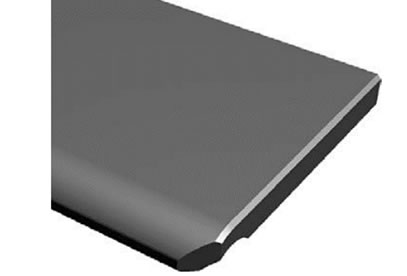 |
Note)
- 1. Processed by machining.
- 2. When manufacturing top plates to a width not noted, edges of top plates will be finished to the above specifications.
- 3. Special edge shapes are available upon request.
- 4. For a top plate with a small width, chamfer dimensions may be smaller accordingly
- 5. Molded chain marks and actual chain width may not be identical because the width of the top plate is machine processed.
Steps 3. Select Wearstrip Material
Select an appropriate wearstrip material based on the chain materials.
Table 2. Wearstrip Material Selection Guide
| Chain | Wearstrip material | Lubrication | |||
|---|---|---|---|---|---|
| Without | yes | ||||
| Abrasives | |||||
| Without | yes | Without | yes | ||
| Stainless steel top chain ・Straight running ・Sideflexing |
Stainless | D | D | B | B |
| steel | D | C | B | A | |
| Plastic rail (P rail ) PLF rail |
A | × | A | × | |
| M rail SJ-CNO |
A | × | × | × | |
| Plastic top chain Plastic block chain Plastic modular chain (Mold-to-Width type ) ・Straight running ・Sideflexing |
Stainless | B | D | A | A |
| steel | A | C | D | D | |
| Plastic rail (P rail ) | D | × | A | × | |
| PLF rail | B | × | A | × | |
| M rail SJ-CNO |
A | × | × | × | |
Note)
- 1. A: Strongly recommended, B: Recommended, C: Very usable, D: Usable, ×: Not appropriate
- 2. Stainless steel top chain lambda specifications should be used without lubrication.
- 3. Select stainless steel or steel wearstrips for KV series chains for normal temperatures, and a stainless steel wearstrip for high-temperature (over 50°C) applications.
- 4. Recommended metal wearstrip material is cold-rolled metal.
- 5. The recommended lubricant for steel rails is oil.
Material, Color and Features of Plastic Wearstrips
| Material, color | Features | |
|---|---|---|
| Plastic rail (P rail ) |
Ultra high molecular weight polyethylene (Color :White or green color ) |
・Most commonly used rail ・Machined or extruded products ・For plastic top chain, recommended for use in wet conditions ・Low water absorption; chemical and impact resistance are also excellent |
| PLF rail | Low friction and wear resistance Ultra high molecular weight polyethylene (Color :white ) |
・Lower friction and more wear resistant than P rail ・Machined or extruded products |
| M rail SJ-CNO |
Special polyamide (M rail :Color :Blue color ) (SJ-CNO:Color :Purple color ) |
・Rail for dry conditions only ・Wear resistant ・Machined item |
Note) Operating Temperature Range
Plastic rail (P rail), PLF rail:-20℃~60℃
M rail, SJ-CNO:-20℃~80℃
Steps 4. Determine Coefficient
Coefficient shown in table 3 to 6 are based on in house test data.
These values may differ depending on the operation conditions, atmosphere, shape of the conveyed products, chain grime, and other conditions. Use these factors to calculate chain tension shown in step 5.
Table 3. Coefficient of Dynamic Friction between Top Plate and Wearstrip (μ1、μ2)
| Wearstrip and conveyed material | Lubricated | Top Plate Material/Package | |||||||||||
|---|---|---|---|---|---|---|---|---|---|---|---|---|---|
| Stainless Note) 1 |
steel | Polyacetal | KV Note) 2 | DIA MPD |
HTW | MF | HS | ||||||
| Standard Series Note) 3 | Low Friction Specifications Note) 4 | CB | ALF | ||||||||||
| Wearstrip material (μ1) | Stainless | No lube (dry) | 0.35 | 0.35 | 0.25 | 0.20 | - | 0.14 | 0.25 | 0.30 | 0.35 | 0.27 | 0.25 |
| water-lubricated | 0.35 | - | 0.25 | 0.20 | - | 0.14 | 0.25 | - | 0.35 | - | - | ||
| Soapy water | 0.20 | - | 0.15 | 0.15 | - | 0.11 | 0.16 | - | 0.20 | - | - | ||
| Oil | 0.20 | 0.20 | - | - | - | - | - | - | - | - | - | ||
| steel | No lube (dry) | 0.35 | 0.35 | 0.25 | 0.17 | - | 0.14 | 0.25 | 0.30 | 0.35 | 0.27 | 0.25 | |
| water-lubricated | - | - | - | - | - | - | - | - | - | - | - | ||
| Soapy water | - | - | - | - | - | - | - | - | - | - | - | ||
| Oil | 0.20 | 0.20 | - | - | - | - | - | - | - | - | - | ||
| Plastic rail (P rail ) M rail Note) 5 |
No lube (dry) | 0.25 | 0.25 | 0.25 | 0.20 | 0.20 | 0.15 | - | 0.30 | 0.30 | 0.27 | - | |
| water-lubricated | 0.25 | - | 0.25 | 0.20 | 0.20 | 0.15 | - | - | 0.30 | - | - | ||
| Soapy water | 0.15 | - | 0.15 | 0.13 | - | 0.11 | - | - | 0.20 | - | - | ||
| Oil | 0.15 | 0.15 | - | - | - | - | - | - | - | - | - | ||
| SJ-CNO Note) 5 | No lube (dry) | 0.20 | 0.20 | 0.20 | 0.15 | - | 0.13 | - | 0.30 | 0.24 | 0.22 | 0.25 | |
| water-lubricated | 0.20 | - | 0.20 | 0.15 | - | 0.13 | - | - | 0.24 | - | - | ||
| Soapy water | 0.15 | - | 0.12 | 0.12 | - | 0.11 | - | - | 0.20 | - | - | ||
| Oil | 0.15 | 0.15 | - | - | - | - | - | - | - | - | - | ||
| PLF rail | No lube (dry) | - | - | 0.18 | 0.14 | - | 0.12 | - | - | - | - | - | |
| water-lubricated | - | - | 0.18 | 0.14 | - | 0.12 | - | - | - | - | - | ||
| Soapy water | - | - | 0.12 | 0.12 | - | 0.11 | - | - | - | - | - | ||
| Oil | - | - | - | - | - | - | - | - | - | - | - | ||
| Conveyed material (μ2) | Metal can | No lube (dry) | 0.35 | - | 0.25 | 0.20 | 0.19 | 0.14 | 0.23 | 0.30 | 0.35 | 0.28 | 0.22 |
| water-lubricated | 0.35 | - | 0.25 | 0.20 | 0.19 | 0.14 | 0.23 | - | 0.35 | - | - | ||
| Soapy water | 0.20 | - | 0.14 | 0.13 | - | 0.11 | 0.15 | - | 0.20 | - | - | ||
| Oil | - | - | - | - | - | - | - | - | - | - | - | ||
| Glass bottle | No lube (dry) | 0.25 | - | 0.22 | 0.14 | 0.12 | 0.10 | 0.18 | 0.25 | 0.22 | 0.25 | - | |
| water-lubricated | 0.25 | - | 0.22 | 0.14 | 0.12 | 0.10 | 0.18 | - | 0.22 | - | - | ||
| Soapy water | 0.20 | - | 0.14 | 0.14 | - | 0.10 | 0.15 | - | 0.10 | - | - | ||
| Oil | - | - | - | - | - | - | - | - | - | - | - | ||
| Plastic container | No lube (dry) | 0.35 | - | 0.25 | 0.17 | 0.16 | 0.13 | 0.20 | 0.30 | 0.30 | 0.28 | 0.20 | |
| water-lubricated | 0.35 | - | 0.25 | 0.17 | 0.16 | 0.13 | 0.20 | - | 0.30 | - | - | ||
| Soapy water | 0.20 | - | 0.15 | 0.13 | - | 0.11 | 0.15 | - | 0.20 | - | - | ||
| Oil | - | - | - | - | - | - | - | - | - | - | - | ||
| Paper package | No lube (dry) | 0.40 | - | 0.31 | 0.29 | 0.29 | 0.22 | 0.35 | 0.38 | 0.35 | 0.38 | 0.32 | |
| water-lubricated | 0.40 | - | 0.31 | 0.29 | 0.29 | 0.22 | 0.35 | - | - | - | - | ||
| Soapy water | 0.20 | - | 0.20 | 0.20 | - | 0.12 | 0.20 | - | - | - | - | ||
| Oil | - | - | - | - | - | - | - | - | - | - | - | ||
Note)
- 1. Stainless steel top chain lambda specifications should be used without lubrication.
- 2. For KV series, the coefficient of friction listed is for room temperature. Under temperature conditions that exceed 50˚C, use the dynamic friction coefficient 0.35. KV150 series is only for dry conditions.
- 3. Standard series, Y, E, DIY, MPW, AR, UVR series and Plastic Crescent Chain.
- 4. LFW, LFG, LFB, NLF, WR, HG, MWS series.
- 5. M rail and SJ-CNO are only for dry use conditions.
- 6. With water lubrication, stainless steel pins will prematurely be worn and elongated earlier than plastic pins.
- 7. Depending on the type of conveyed product, the coefficient of dynamic friction coefficient can be greater than the values in (μ2), which can result in adsorption. To determine sliding performance, it is recommended that coefficient of friction be measured for each type of object conveyed.
Table 4. Coefficient of Rolling Friction (μ3) between Conveyed Products and Plastic Rollers
| Chain type | Rolling friction coefficient |
|---|---|
| Accumulation Chain TTPDH-LBP Curved accumulation chain TPUS-LBP, TPUS-Y-LAP-LFB-MFR |
0.10 |
| Curved accumulation chain TPUS-Y-LAP, TP-30UTW-LAP, TP-36UTW-LAP | 0.07 |
Table 5.Angle Factor (αL) and Length Factor (αS) when Using Curved Wearstrips
| Top Plate Material | Lubricated | Sideflex angle | |||||||
|---|---|---|---|---|---|---|---|---|---|
| 30° | 60° | 90° | 120° | 150° | 180° | ||||
| Angle factor (αL) | Stainless steel or steel | No lube or water | 1.20 | 1.45 | 1.75 | 2.10 | 2.50 | 3.00 | |
| Soapy water | 1.10 | 1.25 | 1.35 | 1.50 | 1.70 | 1.85 | |||
| Oil | 1.10 | 1.25 | 1.35 | 1.50 | 1.70 | 1.85 | |||
| Polyacetal | Standard Series Note) 3 | No lube or water | 1.15 | 1.30 | 1.50 | 1.70 | 1.90 | 2.20 | |
| Soapy water | 1.10 | 1.15 | 1.25 | 1.35 | 1.50 | 1.60 | |||
| Low Friction Specifications Note) 4 | No lube or water | 1.10 | 1.25 | 1.35 | 1.50 | 1.70 | 1.85 | ||
| Soapy water | 1.10 | 1.15 | 1.25 | 1.35 | 1.50 | 1.60 | |||
| CB | No lube or water | 1.10 | 1.25 | 1.35 | 1.50 | 1.70 | 1.85 | ||
| Soapy water | - | - | - | - | - | - | |||
| ALF | No lube or water | 1.10 | 1.15 | 1.25 | 1.35 | 1.50 | 1.60 | ||
| Soapy water | 1.05 | 1.10 | 1.20 | 1.25 | 1.35 | 1.40 | |||
| KVNote) 2 | No lube or water | 1.15 | 1.30 | 1.50 | 1.70 | 1.90 | 2.20 | ||
| Soapy water | 1.10 | 1.20 | 1.30 | 1.40 | 1.50 | 1.65 | |||
| DIA,MPD | No lube (dry) | 1.15 | 1.35 | 1.60 | 1.85 | 2.20 | 2.55 | ||
| HTW | No lube or water | 1.20 | 1.45 | 1.75 | 2.10 | 2.50 | 3.00 | ||
| Soapy water | 1.10 | 1.25 | 1.35 | 1.50 | 1.70 | 1.85 | |||
| MF | No lube (dry) | 1.15 | 1.35 | 1.55 | 1.75 | 2.05 | 2.35 | ||
| HS | No lube (dry) | 1.15 | 1.30 | 1.50 | 1.70 | 1.90 | 2.20 | ||
| Length factor (αS) | 0.5 | 1 | 1.6 | 2.1 | 2.6 | 3.1 | |||
Note)
- 1. It is recommended that sideflexing conveyors be lubricated so that the chain slides smoothly on the wearstrip. In particular, when the sideflex radius spans an angle greater than 90°, the chain and the wearstrip will wear unevenly in a relatively short period of time, and chain float may occur. If lubrication is impossible, consider using a corner disc in the horizontal curved section.
- 2. Values for the KV series are for room temperature. For high temperature (over 50˚), apply the value of “no lubrication” or “water lubrication” in “stainless steel” or “steel”.
- 3. Standard, Y, E, DIY, MPW, UVR series and Plastic Crescent Chain.
- 4. LFW, LFG, LFB, NLF, WR, HG, MWS series.
Table 6. Angle Factor when Using Corner Discs (αc)
| Chain type | Angle factor (αc) |
|---|---|
|
TPUSR550 TPUSR826 TPUH-BO TPUN555 TPUN550-LH TPUN535-LH TP-UB36 TP-50UNS (including D76 ) |
Corner disc with integral bearing :1.1 Corner disc without integral bearing :1.15 |
Note)
- 1. The αC factor is used for sideflexing movement of chains using corner discs, and is constant regardless of the sideflex angle.
- 2. TOS Plastic Crescent Chain uses sprockets in the corners. Use the values in the table above if the sprocket shaft hole includes an integral bearing.
Steps 5. Calculate Chain Tension and Power Required
5-1. Calculating Tension (F) for Straight-Running Movement
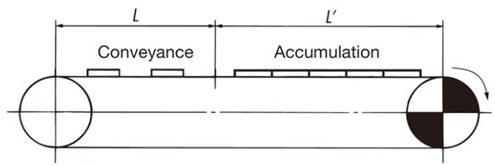
Note) SI units and gravimetric units
The formulas are given for both SI units and gravimetric units. When calculating tension F with gravimetric units, the weight (kgf) in gravimetric units is the same value as the mass (kg) in SI units.
Explanation of symbols
- F = Chain tension kN{kgf}
- m1 = Chain mass (kg/m)
- L = Length of conveying portion (m)
- m2 = Mass of conveyed objects in conveying portion (kg/m)
- L' = Length of accumulating portion (m)
- m3 = Mass of conveyed objects in accumulating portion (kg/m)
- μ1 = Coefficient of dynamic friction between chain and wearstrip (See Table 3 )
- μ2 = Coefficient of dynamic friction between conveyed products and chain in accumulated section (See Table 3 )
- μ3 = Coefficient of rolling friction between conveyed products and plastic rollers (See Table 4 )
- αL = Angle factor when using curved wearstrips (See Table 5 )
- αC = Angle Factor when Using Corner Discs (See Table 6 )
- αS = Length factor (See Table 5 )
- θ = Inclination angle ( Deg. )
- r = sideflex radius (m)
- P = Power required (kW)
- V = Chain speed (m/min)
- ηNote) = Transmission efficiency of drive unit
Note) For the mechanical transmission efficiency, check the drive unit used.
SI Unit (kN)
Chain tension
F = 9.80665 × 10-3 { (2.1m1 + m2) L・μ1 + (2.1m1 + m3) L'・μ1 + m3・L'・μ2 }
Power required
P = F・V 60η
Gravity unit (kgf)
Chain tension
F = (2.1m1 + m2) L・μ1 + (2.1m1 + m3) L'・μ1 + m3・L'・μ2
Power required
P = F・V 6120η
Note) When using accumulation chains (such as TTPDH-LBP), calculate by substituting µ3 for µ2 in the equations above.
5-2. Calculating Tension (F) for sideflexing conveyance (with one curved section)
The calculation is basically the same as for straight conveyance. The tension acting on the corner part is corrected using the angle coefficient.
A calculation example is shown for the conveyor route below. Lubrication is recommended for curved conveyance where the chain and wearstrip slide against each other. In particular, when the sideflex radius spans an angle greater than 90°, the chain and the wearstrip will wear unevenly in a relatively short period of time, and chain float may occur. If lubrication is impossible, consider using a corner disc in the horizontal curved section.
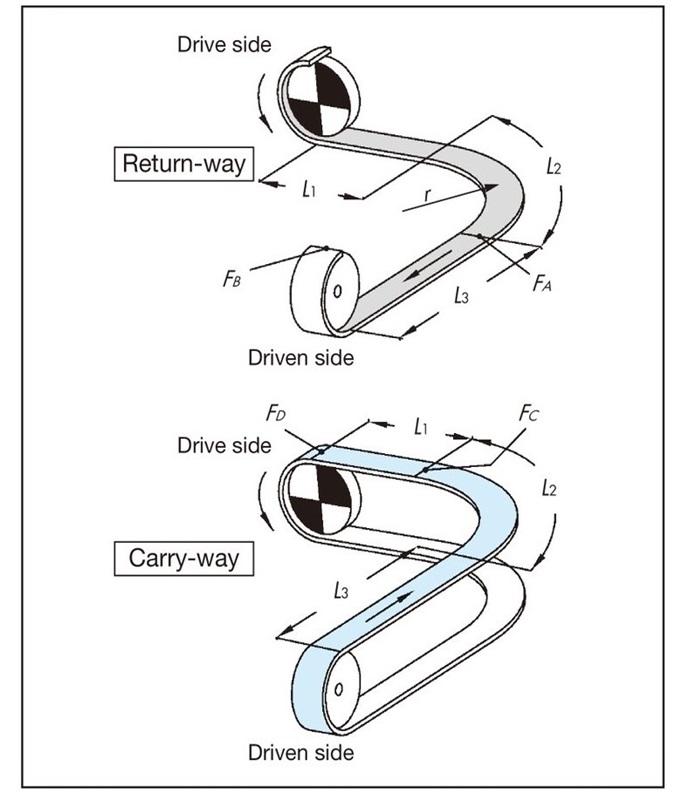
F = 9.80665 × 10-3 ・FD (kN)
Tension at return-way
[Tension at section A :FA]
FA = m1(L1 + L2) μ1・αL 90°
L2 = r × αS 90°
[Tension at section B :FB]
FB = 1.1 ×(FA + m1・L3・μ1)
Tension at carry-way
[Tension at section C :FC]
FC ={FB + (m1 + m2) (L2 + L3) μ1 + m3 (L2 + L3) μ2}・αL 90°
L2 = r × αS 90°
[Tension at section D :FD]
FD = FC + {(m1 + m2) L1・μ1 + m3・L1・μ2}
Note
- 1. When using curved accumulation chains (such as type TPUS-LBP), calculate by substituting μ3 for μ2 in the equations above.
- 2. When using corner discs in the curved section, replace the angle factor αL with the corner disc angle factor αC for calculation.
5-3. Calculating Tension (F) for Sideflexing Conveyance (with Two Curved Sections)
When sliding the chain against curved wearstrip, no more than two 90° curves should be allowed in one conveyor. Otherwise it may cause pulsation of the chain movement.
To include additional curved sections, consider splitting the conveyor into sections or use the corner disc system.
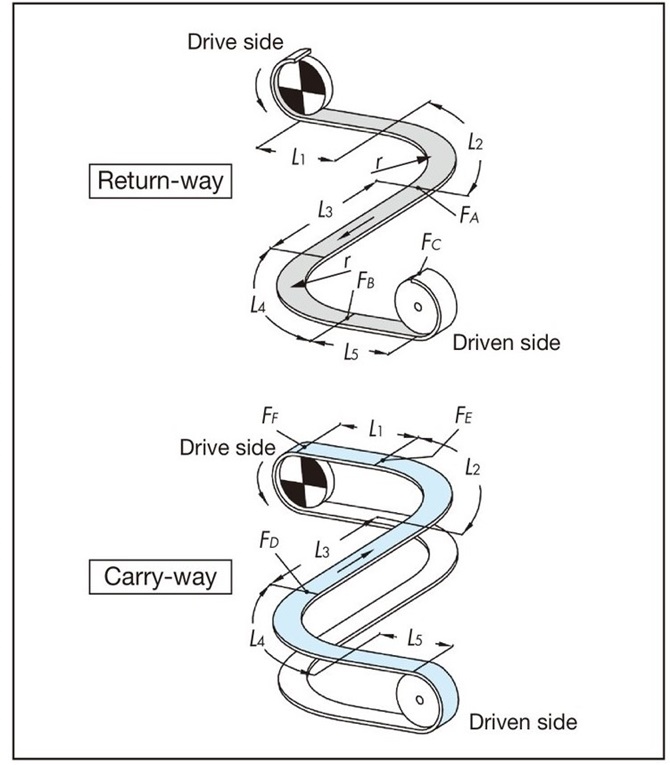
F = 9.80665 × 10-3 ・FF (kN)
Tension at return-way
[Tension at section A :FA]
FA = m1(L1 + L2) μ1・αL 90°
L2 = r × αS 90°
[Tension at section B :FB]
FB = {FA + m1(L3 + L4) μ1} αL 90°
L4 = r × αS 90°
[Tension at section C :FC]
FC = 1.1 × (FB + m1・L5・μ1)
Tension at carry-way
[Tension at section D :FD]
FD = {FC + (m1 + m2) (L4 + L5) μ1 + m3(L4 + L5) μ2}・αL 90°
L4 = r × αS 90°
[Tension at section E :FE]
FE = {FD + (m1 + m2) (L2 + L3) μ1 + m3(L2 + L3) μ2}・αL 90°
L2 = r × αS 90°
[Tension at section F :FF]
FF = FE + (m1 + m2) L1μ1 + m3・L1・μ2
Note
- 1. When using curved accumulation chains (such as type TPUS-LBP), calculate by substituting μ3 for μ2 in the equations above.
- 2. When using corner discs in the curved section, replace the angle factor αL with the corner disc angle factor αC for calculation.
5-4. Calculating Tension (F) for Sideflexing Movement (Horizontal Drive)
| Applicable Chains | TPUH-BO (horizontal conveyance), Plastic Crescent Chain (TORP, TOSP), Stainless Steel Top Chain (TO, TU) |
|---|
The calculation is basically the same as for straight conveyance. The tension acting on the corner part is corrected using the angle coefficient.
A calculation example is shown for the conveyor route below.

F = 9.80665 × 10-3 ・FC (kN)
[Tension at section A :FA] FA = (m1 + m2)・L1・μ1
[Tension at section B :FB] FB = {FA + (m1 + m2)・L2・μ1}・αC L2 = r・αS 180°
[Tension at section C :FC] FC = FB + (m1 + m3)・L1・μ1 + m3・L1・μ2
5-5. Calculating Tension (F) for Sideflexing Movement (with one Curved Section) of TTUP(T)-M and TTUPM838H
The coefficient values shown in Table 7 is obtained from our in-house experiment. The values are subject to different variables such as operating conditions, shape and material of conveyed products.
The value will be used in the tension calculations.
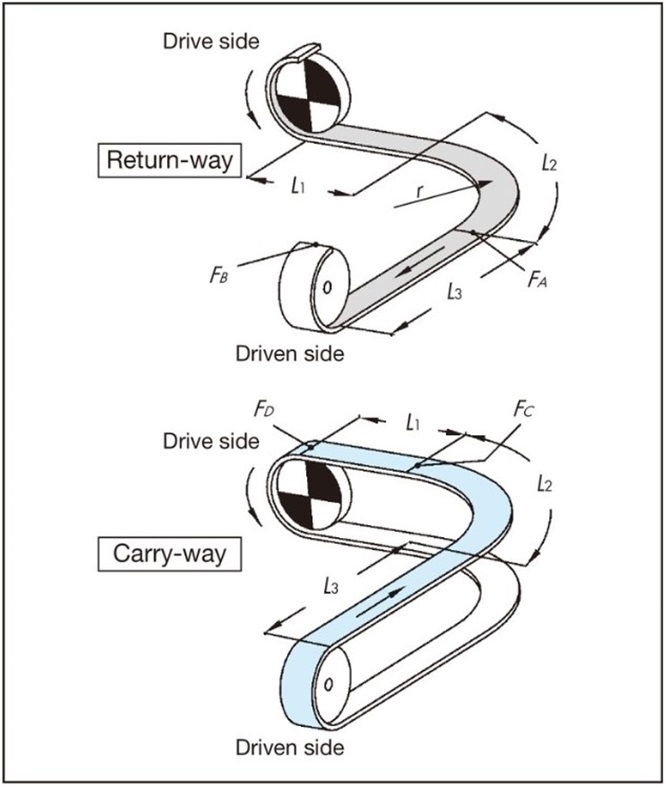
F = 9.80665 × 10-3 ・FD (kN)
Tension at return-way
[Tension at section A :FA]
FA = m1(L1 + L2) μ1・αL 90°
L2 = r × αS 90°
[Tension at section B :FB]
FB = 1.1 ×(FA + m1・L3・μ1)
Tension at carry-way
[Tension at section C :FC]
FC = {FB + (m1 + m2) L2・(μ1 + μ4) + (m1 + m2)・L3・μ1 + m3
(L2 + L3)・μ2} × αL 90°
L2 = r × αS 90°
[Tension at section D :FD]
FD = FC + {(m1 + m2) L1・μ1 + m3・L1・μ2}
Table 7. Magnet Coefficients (μ4)
| Magnet coefficients | ||
|---|---|---|
| Lubricated | No lube or water | |
| Top Plate Material | CB | 0.47 |
| ALF | ||
| HG | ||
5-6. Calculating Tension (F) for Inclined Movement
The effects of speed, conveyed products, center of gravity, mass, environment, and other parameters will make it difficult to determine precisely the maximum inclination angle.
Although the values given in Table 8 can serve as guidelines, it will be necessary to perform tests.
Table 8. Calculating Tension for Inclined Movement
| Chain material | No lube (dry) | Soapy water | Oil |
|---|---|---|---|
| Steel-based | 10˚ | - | 6˚ |
| Standard Series (Polyacetal) | 5˚ | 3˚ | - |
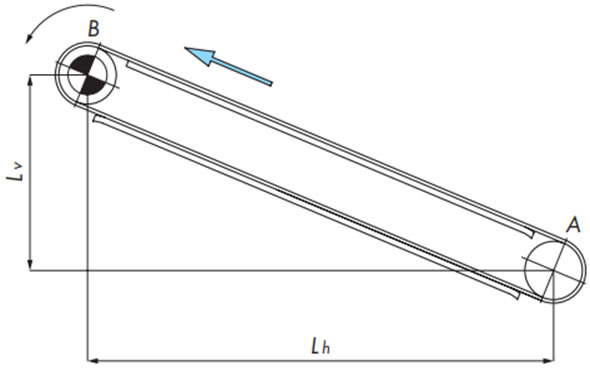
F = 9.80665 × 10-3 ・FB (kN)
Tension at return-way
[Tension at section A :FA]
FA = 1.1m1 (Lh・μ1 - Lv)
FA < 0, FA = 0
Chain load
F = FB
Tension at carry-way
[Tension at section B :FB]
FB = FA + {(m1 + m2) (Lh・μ1 + Lv)}
Steps 6. Decide Chain Model
Select a top chain having a maximum allowable load larger than the maximum tension (F) to be applied to the chain.
To obtain the maximum allowable load, refer to the allowable load graph, and specify the chain speed and operating temperature on the diagram.
See each product page for allowable load graphs.
F ≦ Maximum allowable load of the chain (coupled with speed and temperature )
When the maximum allowable load is insufficient, it can be corrected by using top plates with narrower width and increasing the number of chain strands, or by splitting it into many short conveyors.
Also selecting a chain with a larger maximum allowable load.
To determine an optimum chain model, remember to take environmental conditions into account.










